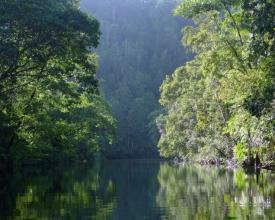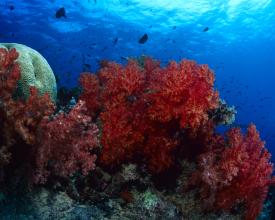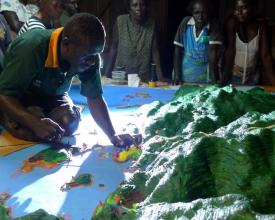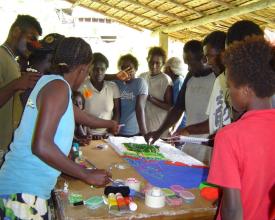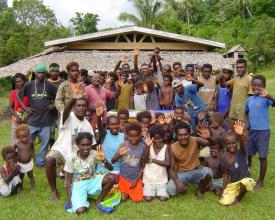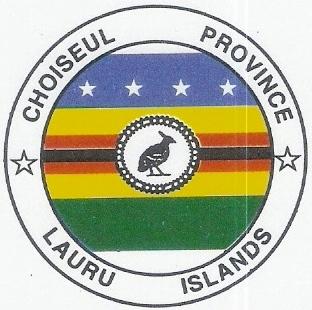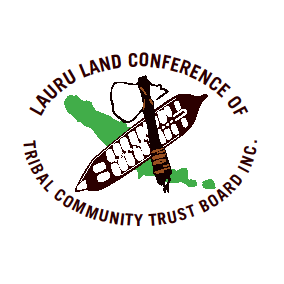
Lauru Ridges to Reefs Protected Area Network (Lauru PAN)
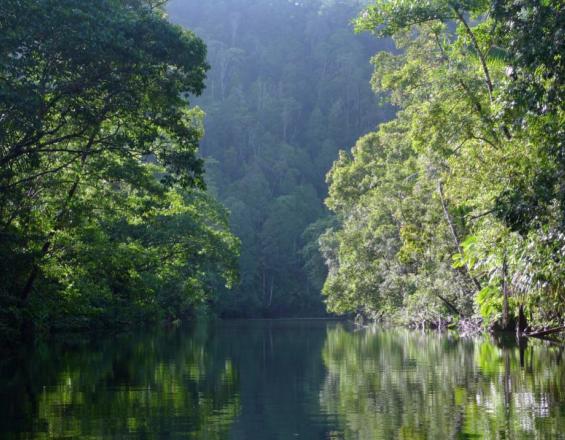
The Lauru PAN in Choiseul Province, Solomon Islands, is the first locally managed marine area (LMMA) network in Melanesia. It was established in a community-led process and based on a master conservation plan that is continuously updated. Good governance and conservation impacts are monitored. The partnership between TNC, LLCTC and Choiseul provincial government results in better protection of marine resources and legal security over access rights.
Context
Challenges addressed
Lauru’s unique marine biodiversity, the highest in the Solomon Archipelago calls for preservation based on better knowledge of its biodiversity, opportunities and threats due to climate change, sea level rise and higher storm frequency. Locally managed marine area implementation needs systematic planning built on scientific and traditional knowledge, and formalized natural resource use rights.
Location
Process
Summary of the process
Building Blocks
Conservation plan built on local and scientific knowledge
Provides the foundation for the LMMA network and helps communities decide which request to prioritize. In a participatory mapping workshop all relevant community and governmental stakeholders map key features, cultural heritage and ecosystem services. MPA planning software (MARXAN) helps to identify options for the most cost-effective networks of protected areas. 3D models link science and local knowledge so that communities can explore land-use options.
Enabling factors
- Awareness of local stakeholders and resource owners of the value, and willingness to protect marine resources
- Strong customary ownership of land and sea
- Technical and financial support from partners, including the provincial government
Lesson learned
It is imperative to settle conflicts over land ownership and internal community agreements before beginning the process of LMMA establishment. For the success of LMMAs, communities must have the lead from establishment to enforcement. It is therefore important to ensure that all groups in the community are engaged and agree to engage in the LMMA project.The use of user friendly and easy to operate marine planning software, such as MARXAN is a helpful tool to guide the decision making process. Of course, also other factors must be taken into account.
Consultative establishment of protected area sites
The community’s request to include a site into the conservation plan is judged by LLCTC’s environment officer based on its conservation value and the community’s level of commitment. Through continuous interactions with the community, the area is explored, and demarcated by GIS references. A committee formed by the community oversees and manages the new protected area. The management plan and map for the new LMMA are created and added to the network master plan.
Enabling factors
- Financial and advisory support by an NGO (TNC) in setting up the network and in supporting each participating community
- A solid partnership between communities and LLCTC
- Commitment for financial support by the provincial government
Lesson learned
For the success of LMMAs, communities must have the lead from establishment to enforcement. It is therefore important to ensure that all groups in the community have agreed to the site proposed to be included as protected area in the network. There is a need to develop more consistent management plans for each site, particularly in the case of recently established conservation areas. Several community management committees lack skills and thus have problems in starting to draft their management plans and also to oversee the management of their protected area. They need capacity and support from LLCTC. Without consistent management plans for each site, there is no accountable oversight and clear representation of regulations for resources harvested or harvesting protocols. Management plans do not need to be in any specific format, but certain principles need to be defined and agreed upon by the whole community.
Continued collaboration between all stakeholders
A process is established between the LLCTC’s environmental officer, the contact point in the community and the community committee through monthly visits that allow for exchange between the management committee and partners to ensure long-term sustainability, commitment and true partnership. These visits also help to address and solve needs and problems that may occur, as well for sharing experiences and cross-learning.
Enabling factors
- LLCTC must be respected by the communities to be effective in their representation
- Financial and human resources to sustain the continuous process
- A solid partnership and trust between the communities and the liaising officer
Lesson learned
The long-term (10 years) technical and advisory assistance provided by the NGO (TNC) and the proven partnership built with the LLCTC representing the communities and the collective chiefs of all communities was the key factor to enable this process. To consistently engage communities over time is essential and demands a lot of time and human resources. Once the feedback is negative as the community feels deserted and abandoned the need to re-invest to recover trust and cooperation is tremendous. High community expectations that may not be met, particularly relating to monetary benefits, need to be managed by clearly articulating what can be achieved, right from the start.
Coordinated monitoring of protected areas
To ensure that the conservation values of the protected area are effectively protected, interested community members are trained in monitoring of trends in fish and invertebrate populations using standardized techniques. Selection of trainees and implementation of continuous monitoring are done in coordination with the community’s management committee.
Enabling factors
- Good partnership between LLCTC and the management committee
- Support of the community and the management committee
Lesson learned
It is important to encourage and support the management committee to play an active role in the management of the conservation areas. They often rely heavily on direction from the LLCTC, and even external partners such as The Nature Conservancy, rather than leading their own planning with targeted and needs-based LLCTC support. Management will never be self-sustaining until the communities no longer require external assistance. This understanding needs strengthening as this is the anticipated way forward for the sites under the Lauru PAN.
Overseeing implementation of the network
Establish a framework that is ensured through an environmental and conservation committee made up by representatives of the LLTC, government, partners (TNC) and the communities involved, and that meets twice a year. The committee is charged with overseeing the implementation of the network in accordance with the conservation master plan and by synthesizing progress made at each protected area thereof.
Enabling factors
- Good partnership between LLCTC, government, partners and the management committees of all communities involved
- Advisory and financial support.
Lesson learned
Word of mouth between communities about benefits of LMMA establishment which is supported by close contact and geographic location enables exchange between communities and leads to submission of many new requests to LLTCC. As a result, the LLCTC is inundated with requests for help in setting up conservation areas, evidence of the success of this idea, but also an indicator that demand outstrips the capacity of LLCTC to respond in a timely manner. Initially there was no legal framework guiding the Lauru PAN since its establishment; however, communities rely very much on the traditional law and practice of dealing with unwanted action and attitudes. A major future challenge will be the financial sustainability of the Lauru PAN after NGOs depart.
Support in developing alternative livelihoods
To help offsetting adverse effects of resource use limitations or conflicting interests, and where feasible, LLCTC explores options of developing alternative incomes, especially where there is a clear opportunity cost incurred through conservation. Options include the integration of ecotourism with conservation, such as building eco-lodges or to develop eco-timber operation as an alternative to industrial logging.
Enabling factors
- Feasibility of eco tourism related investments
- Cooperation and support from external partners, such as NGOs.
Lesson learned
Some tribes and communities expect conservation to provide money immediately, a result of past experience with logging royalties in the Solomon Islands. This thinking will fade provided there is sufficient education and awareness building by local partners. Communities will slowly understand that monetary benefit is not the only benefit. The integration of ecotourism and conservation will potentially support livelihoods in tandem with biodiversity conservation. The Lauru PAN is not just about conservation but to tie resource management, food security and human sustainability. Thus, there is a need to integrate other projects in sites where LLCTC works, not only in view of livelihood projects but also sanitation, and perhaps other basic community infrastructures and services. However, it should be noted that it may sometimes be difficult to provide compatible livelihood options.
Impacts
Local communities as drivers have full ownership in the establishment of the Lauru Ridges to Reefs Protected Area Network. LLCTC is covered by requests further to the 15 sites already set up. Conservation priorities improves stakeholders bargaining power when negotiating with mining companies and the national government about future mining operations. Mapping results in better knowledge of natural, but also cultural resources. Stocks of commercial species, e.g. trochus snails, have noticeably recovered. Alternative livelihood options (ecotourism), have generated revenues.
Beneficiaries
Participating communities and Lauru Land Conference of Tribal Community (LLCTC).
Story
“We’re honoured to be partnered with Lauru’s communities," says Willie Atu, The Nature Conservancy's Solomon Islands Program Manager. "We’re happy to be using our expertise in conservation planning to respond to their needs and their desire to adapt to the threats of climate change." The Choiseul Provincial government is working to sign the protected area network into law. And the Parama reef at the north-western tip of Choiseul, set aside as a marine protected area in 2006, has already seen a remarkable increase in the density of fish and other macro invertebrates. To ensure that results like these last, the Conservancy is looking to establish long-term sustainable financing options for the region. The best example from LLCTC’s work so far on building resilience is in their partnership support to BoeBoe, a small community in Choiseul Province. Its chief David Hakezama states, “We realised that, if we continue to carelessly harvest resources from the mangroves, sea and bush, we will fall short of them in the near future. So, we decided to start managing our resources more wisely and asked LLCTC for support.” As a first step Hakeszma’s community built a 3D model of their environment as a basis for a dynamic land-use plan. ‘Instead of using existing sophisticated maps as a basis we decided to build this 3D model ourselves – out of our memories and with the local knowledge we have. Almost everybody in our community participated and it took several days and nights to finish it.” This bottom-up approach takes into account the local know-how of the people and what might be even more important: It creates pride and ownership. To learn more about 3D modelling in BoeBoe watch the video ‘modelling the future’ (http://www.youtube.com/watch?v=LOL2CdCfRts&feature=youtu.be). Winfried Pitamana, the secondary school principal in BoeBoe, also took part in the participatory 3D modelling session. She confirms:”The model helps us to understand our environment better and plan for the future ourselves. For example, it helps us to understand what climate change and rising sea levels mean for our community. We have to realise that building new houses close to the coast is a waste of time and money and that we have to settle down further inland instead.”
